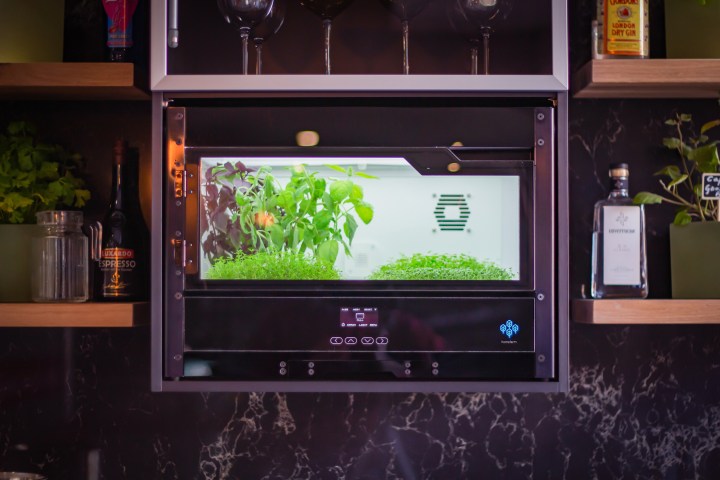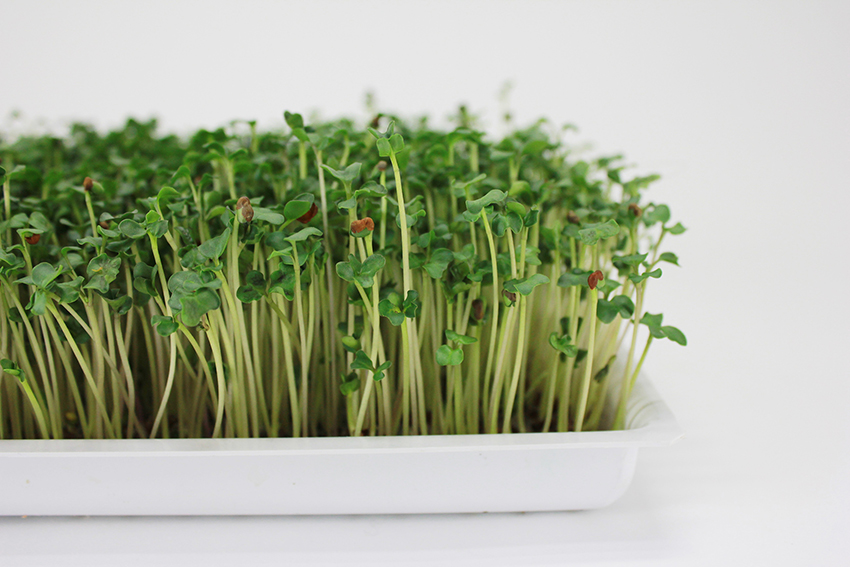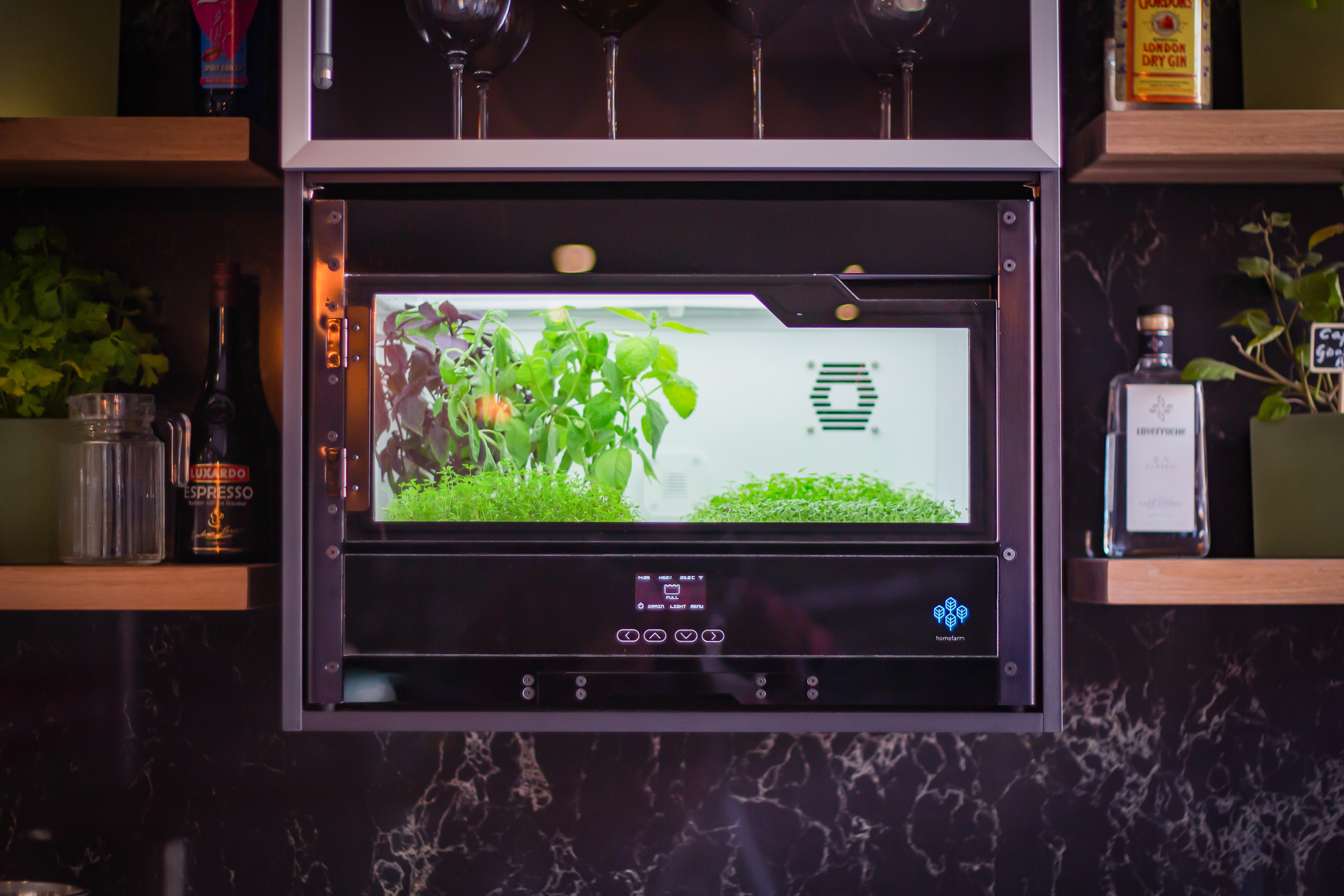CONVERSATION PIECE
Intelligent Food? SA start-up grows artificial intelligence in urban home farming

It’s been a year since HomeFarm, an appliance that semi-autonomously grows leafy greens for you, was launched. The South African team behind it is hoping to push the miniaturised hydroponic farm’s uses, and intelligence, even further. Next stop? An open-source global library of climate algorithms.
You’re about to set off home when you get a notification warning you that the water levels of your HomeFarm are low and need to be topped up ASAP. Your fledgling crop of coriander, broccoli, mizuna and sorrel might suffer if you don’t. You don’t second-guess the appliance, and so put pedal to the metal.
This is not a routine reminder you’ve set, or a panicked message from a flatmate or a stage of some futuristic gardening game. The self-contained, fully-automated farm on your kitchen counter has used your flat’s WiFi to send you this SOS itself.
The founders call HomeFarm a smart home appliance – not a product or gadget. It’s meant to be as familiar, easy to use and as affordable as a specialist coffee machine, just smarter and more independent. It’s meant to provide users with nutrient-dense leafy greens with minimal use of space, time, water, electricity and farming knowledge. They’ve come this far and are hoping to push the appliance’s intelligence and uses even further.

HomeFarm is meant to provide users with nutrient-dense leafy greens with minimal use of space, time, water, electricity and farming knowledge. Image supplied
HomeFarm is a miniature hydroponic “farm” which is small enough to fit onto your kitchen counter, but big enough to deliver more than 300g of microgreens, herbs and bean sprouts each month from four “grow bays”. The appliance regulates its own internal humidity, light, temperature and water levels to keep the microclimate at optimum conditions to produce a yield with maximum nutrients and volume.
All this, and it can communicate. The HomeFarm app guides you through the process, from planting to harvesting, using the “crop calendar”. The appliance uses WiFi to send data to the app, which notifies you to top up the water or harvest a particular bay.
You know almost nothing about farming but here you are, harvesting your third crop of micro broccoli leaves because your little farm told you to. Luckily there’s a recipe book on the app to tell you what to do with it all tomorrow.
This idea came to one of the co-founders during his academic studies. Michael Currin was studying towards his master’s degree in innovation design engineering in London when the idea first started to take shape. His thesis focused on the resilience of food systems in urban environments, especially in the face of climate change.
“I had the idea of decentralising the food system by empowering home dwellers to grow their own food again, particularly those people who maybe don’t have adequate resources or time. With that in mind, I came up with the concept of an appliance that could grow food,” explains Currin.
He happened upon a Canadian product, Urban Cultivator, used by the likes of Martha Stewart as their “automated kitchen garden”. He decided to design and build his own version because this type of appliance wasn’t available to South Africans.
“We are looking at disrupting the supply chain and farming and looking at ways to bring the farm to the consumer. It’s an example of hyper-local farming, which is about cutting out all the inefficiencies that exist in the supply chain like waste, refrigeration, the food miles and the packaging… For us, that’s the ultimate reason for existing,” explains Currin.
They want to assist people who have little time and space in making sure they don’t have to rely on others to produce nutritious food for them, no matter how much or little they know about farming, while producing little waste and consuming no pesticides.
“HomeFarm eliminates all the nuance and knowledge that the farmers have attained over years and years through experience. It creates a user experience that means they can bypass that learning curve and are guaranteed success with the very first planting that they do. That has been our challenge – to create a product that is user-friendly, reliable and to miniaturise the technology into an appliance,” explains Currin.
To fulfil this grand vision, they had to start somewhere and build a platform from which to develop future software and artificial intelligence. The tangible outcome? Those whispy garnishes on your restaurant meal – microgreens.
The appliance miniaturises the climate-controlled hydroponic tunnels used to grow micro greens on a commercial scale. The crops are grown in a growth medium like hemp, rather than soil. The appliance is the tunnel, and the on-board user interface is the brain. It grows these tiny crops for you in under two weeks from planting.

HomeFarm is a miniature hydroponic ‘farm’ small enough to fit onto your kitchen counter, or in a cupboard space designed for a microwave, but big enough to deliver more than 300g of microgreens, herbs and bean sprouts each month from four ‘grow bays’. Image supplied
While clinical studies on the nutritional content of microgreens are few, there are indications that they are denser in certain nutrients compared to the older version of the plant, depending on the particular species and its nutrients.
However, the lack of studies means it’s hard to tell yet what kind of impact they can have on an individual’s health or that of an entire community, explains Gabriel Eksteen, a senior lecturer in nutrition and researcher at the University of Cape Town’s Division of Human Nutrition.
“There is definitely some merit in exploring the health benefits of microgreens more. They are something you can cultivate a little bit more easily at home. Growing fruit and herbs at home is often not very attainable for most people. The amount you need to grow of a crop to make a significant contribution to your diet is not something most people can do in a small back garden or flat. With microgreens, there is that possibility.
“On the flip side of that is the value for money perspective which also needs to be explored. If you look at how much microgreens cost at a retailer, for the equivalent amount of weight of something like spinach you’ll probably pay five to 10 times as much. So, are you getting that extra benefit from adding 20g of microgreens to your diet versus 200g of spinach?
“But if you’re growing it at home and it’s a cost-neutral thing which you add to your diet, then I think it should be an advantage to your diet because the more variety of plant foods and greens you have in your diet the better,” he explains.
As they’ve had the time and money to do more research and develop, they have launched other crops. The appliance can now grow bean sprouts and microherbs which have their own nutrients to offer.
The team is under no illusion that this appliance is a household necessity. At R9,500 for the appliance and two grow mats to grow niche crops, it has a way to go before it attains mass-market appeal. They hope to decrease its price in time as their production increases and refines – right now, they manufacture only as orders come in.
In addition to creating HomeFarms of different sizes and uses, another dream is to create a library of climate algorithms. Users would be able to use the app to select a specific climate for their HomeFarm in order to grow a very climate-specific crop.
“Over time, we want to create these climate libraries which are open-source so that people around the world can develop these climate algorithms and send it to us and we will test and approve them and then add them to the library,” explains Currin.
Ultimately, they want to create a seamless interaction between the product and the app. They would like to get to a point where the user can control the product completely remotely using just the app.
“In the world of start-ups, the future is next week!” chuckles Currin. Right now, they are prepping to raise their next round of investments. If they get that right, they hope to expand in the local market and get ready to launch the appliance abroad.
After that? The AI’s the limit. DM





 Become an Insider
Become an Insider